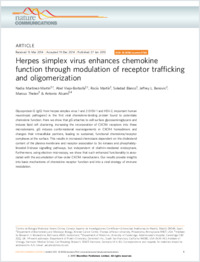Herpes simplex virus enhances chemokine function through modulation of receptor trafficking and oligomerization
- Martinez-Martin, Nadia Centro de Biologia Molecular Severo Ochoa, Consejo Superior de Investigaciones Científicas—Universidad Autónoma de Madrid, Madrid, Spain
- Viejo-Borbolla, Abel Centro de Biologia Molecular Severo Ochoa, Consejo Superior de Investigaciones Científicas—Universidad Autónoma de Madrid, Madrid, Spain
- Martín, Rocío Centro de Biologia Molecular Severo Ochoa, Consejo Superior de Investigaciones Científicas—Universidad Autónoma de Madrid, Madrid, Spain
- Soledad, Blanco Centro de Biologia Molecular Severo Ochoa, Consejo Superior de Investigaciones Científicas—Universidad Autónoma de Madrid, Madrid, Spain
- Benovic, Jeffrey L. Department of Biochemistry and Molecular Biology, Kimmel Cancer Center, Thomas Jefferson University, Philadelphia, Pennsylvania, USA
- Thelen, Marcus Institute for Research in Biomedicine (IRB), Faculty of Biomedical Sciences, Università della Svizzera italiana, Switzerland
- Alcamí, Antonio Centro de Biologia Molecular Severo Ochoa, Consejo Superior de Investigaciones Científicas—Universidad Autónoma de Madrid, Madrid, Spain - Department of Medicine, University of Cambridge, Addenbrooke’s Hospital, Cambridge, UK
-
27.01.2015
Published in:
- Nature communications. - 2015, vol. 6, p. 6163
English
Glycoprotein G (gG) from herpes simplex virus 1 and 2 (HSV-1 and HSV-2, important human neurotropic pathogens) is the first viral chemokine-binding protein found to potentiate chemokine function. Here we show that gG attaches to cell surface glycosaminoglycans and induces lipid raft clustering, increasing the incorporation of CXCR4 receptors into these microdomains. gG induces conformational rearrangements in CXCR4 homodimers and changes their intracellular partners, leading to sustained, functional chemokine/receptor complexes at the surface. This results in increased chemotaxis dependent on the cholesterol content of the plasma membrane and receptor association to Src-kinases and phosphatidylinositol-3-kinase signalling pathways, but independent of clathrin-mediated endocytosis. Furthermore, using electron microscopy, we show that such enhanced functionality is associated with the accumulation of low-order CXCR4 nanoclusters. Our results provide insights into basic mechanisms of chemokine receptor function and into a viral strategy of immune modulation.
- Language
-
- English
- Classification
- Medicine
- License
-
Rights reserved
- Open access status
- gold
- Identifiers
-
- RERO DOC 326863
- DOI 10.1038/ncomms7163
- ARK ark:/12658/srd1319033
- Persistent URL
- https://n2t.net/ark:/12658/srd1319033
Statistics
Document views: 155
File downloads:
- Texte intégral: 191
